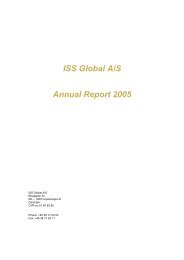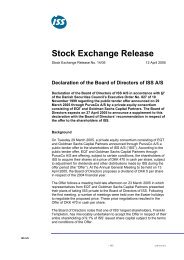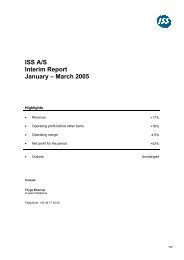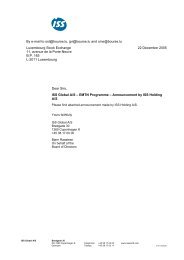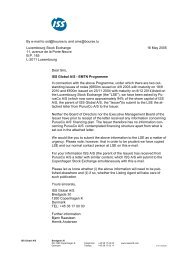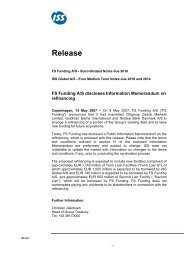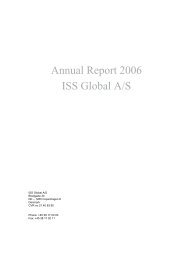I. Table of Contents - ISS
I. Table of Contents - ISS
I. Table of Contents - ISS
Create successful ePaper yourself
Turn your PDF publications into a flip-book with our unique Google optimized e-Paper software.
tatiana\Bank Book\Public Bank Book\FINAL <strong>ISS</strong> PUBLIC Bank IM - Press Release to EMTN_1.doc 9 Nov 2005 10:32 77/91<br />
77<br />
Historical Financial Information<br />
100% in recent years. However, this reduction in working capital requirements is to some extent <strong>of</strong>fset<br />
by the growth <strong>of</strong> the Company in Continental European and International markets where average<br />
receivable days are typically less favourable than in Northern Europe. In September 2005 average<br />
receivable days were 62 days in Continental Europe, while in Northern Europe the average receivable<br />
days were 32 days. When comparing September 2005 average receivable days <strong>of</strong> individual countries<br />
within Europe the range varies from 16 days in Finland to 94 days in Italy.<br />
Figure 21: Development in Receivable Days Outstanding, 2000-2004<br />
Note:<br />
Receivables Days Outstanding<br />
45<br />
49<br />
47<br />
2000 2001 2002 2003 2004<br />
(1) Defined as (Accounts Receivable) divided by ((Revenue for the total number <strong>of</strong> months plus VAT) divided by 30 days)<br />
Source: <strong>ISS</strong><br />
E. Seasonality<br />
The demand for traditional facility services is generally stable and there appears to be limited<br />
seasonality in the quarterly revenue development over the historical period. However, some <strong>of</strong> the<br />
services <strong>ISS</strong> provides experience seasonality. In particular, demand for the landscaping and pest<br />
control services <strong>of</strong> property services segment are significantly higher in the summer months than in<br />
the fall and winter, which may cause Revenues to be higher in the second and third quarter <strong>of</strong> the year<br />
and lower in the first and fourth quarters. However, given the impact by the timing <strong>of</strong> acquisitions in<br />
particular 2000 and 2001, makes it very difficult to compare quarterly revenue development, hence no<br />
direct conclusions can be drawn.<br />
Figure 22: <strong>ISS</strong> Revenues, 2001-Q3 2005, by Quarter<br />
DKK million<br />
25,000<br />
20,000<br />
15,000<br />
10,000<br />
Source: <strong>ISS</strong><br />
5,000<br />
0<br />
Q1 Q2 Q3 Q4<br />
8,153<br />
8,559<br />
8,804<br />
9,336<br />
9,300<br />
9,683<br />
9,521<br />
9,480<br />
8,917<br />
9,013<br />
8,931<br />
9,304<br />
45<br />
9,244<br />
9,743<br />
10,411<br />
10,957<br />
FY01 FY02 FY03 FY04 FY05<br />
10,845<br />
44<br />
11,677<br />
11,635



